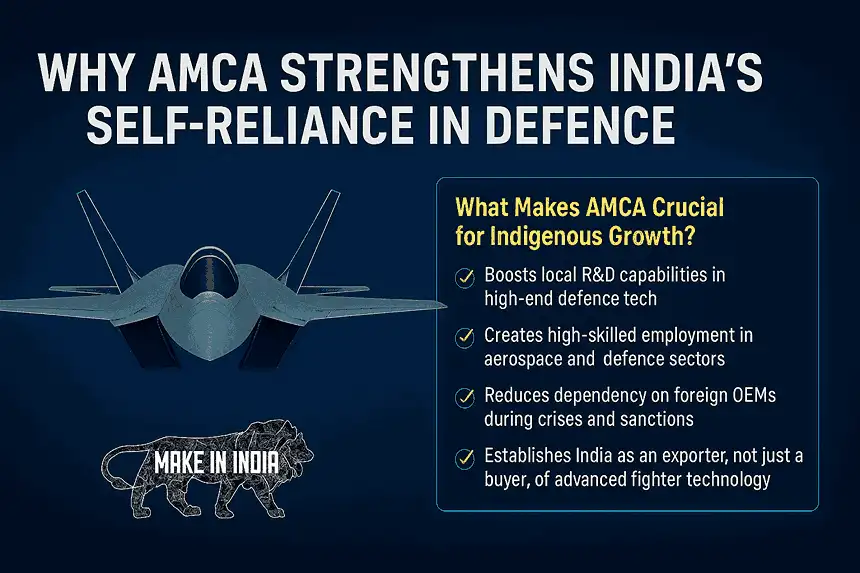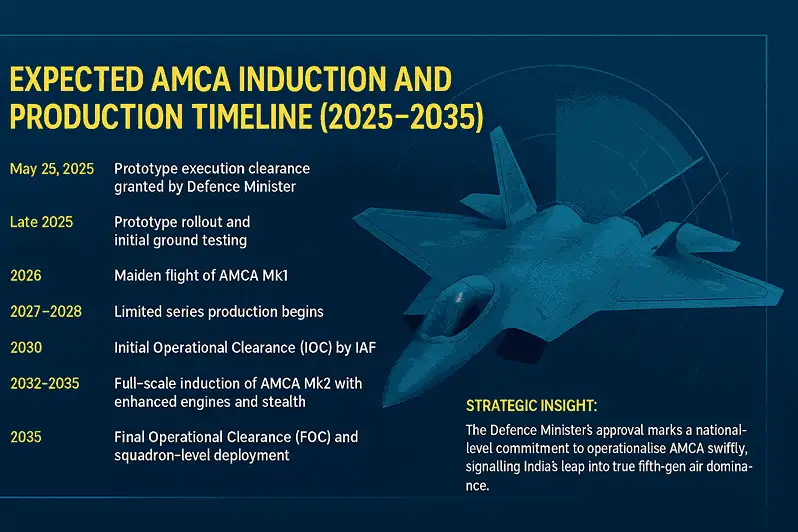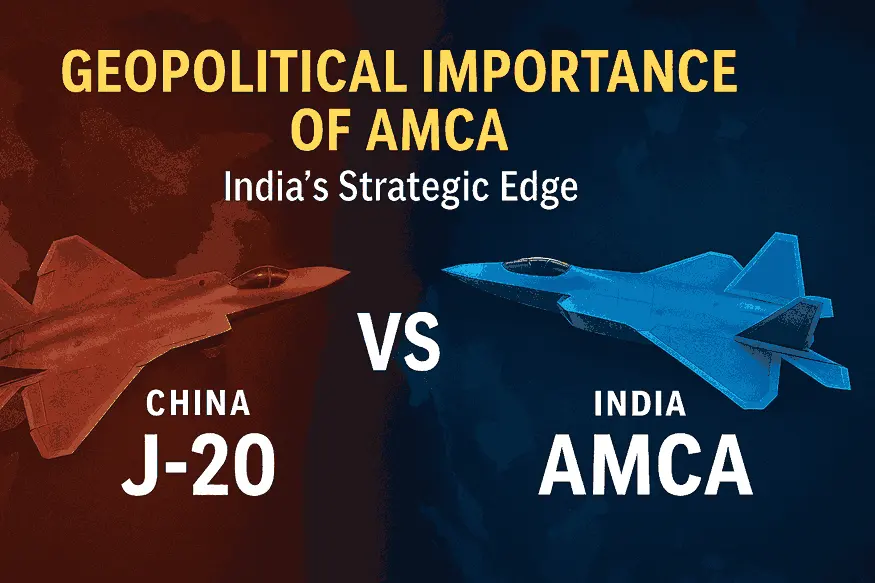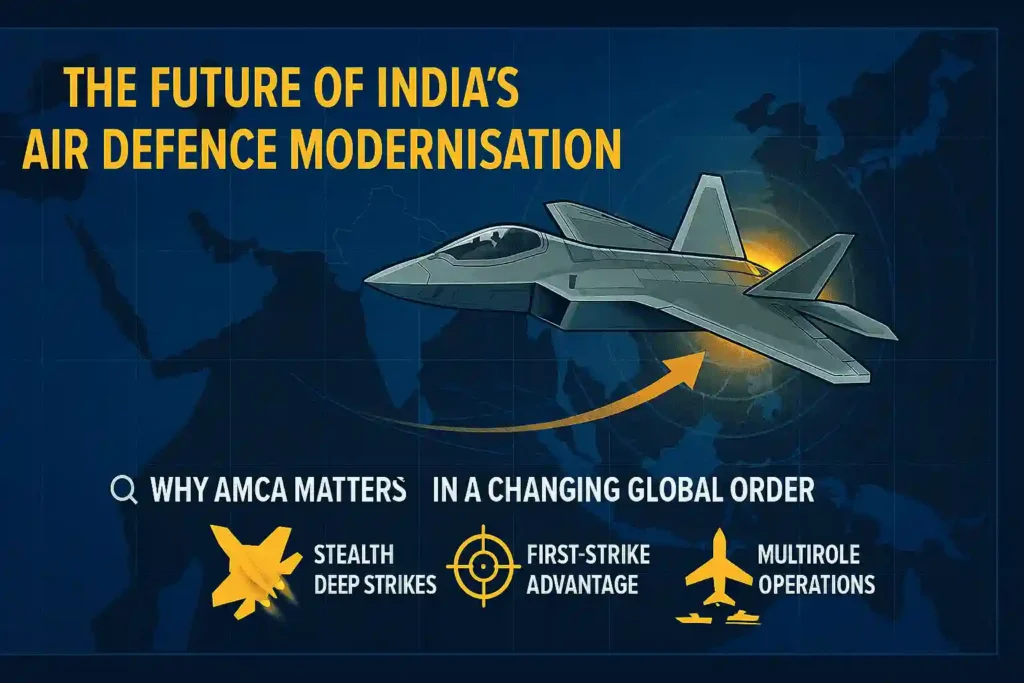The geopolitical importance of AMCA (Advanced Medium Combat Aircraft) extends far beyond the boundaries of air combat—it represents a bold declaration of India’s strategic autonomy in an increasingly turbulent world. As global military tensions rise across the Indo-Pacific, South Asia, and Eastern Europe, India’s decision to develop its fifth-generation stealth fighter jet is both a defensive necessity and a geopolitical statement.
Developed by the Aeronautical Development Agency (ADA) in collaboration with HAL and DRDO, the AMCA project signals India’s shift from being a major arms importer to becoming a technology-driven defence innovator. It aligns with national goals such as ‘Atmanirbhar Bharat’ and ‘Make in India’, while also boosting India’s deterrence posture against rising regional threats from China and Pakistan.
But why does AMCA matter so much in the geopolitical landscape?
- What does it mean for India’s strategic independence?
- How does it reshape power dynamics in South Asia and beyond?
- Can AMCA position India among the global elite of stealth aircraft?
This article explores these critical questions—breaking down the AMCA’s strategic value, its role in shaping India’s future air dominance, and how it fits into the evolving global military order.
1. Why AMCA Strengthens India’s Self-Reliance in Defence

One of the core pillars behind the geopolitical importance of AMCA is its role in promoting self-reliance in defence manufacturing. By building a homegrown fifth-generation fighter jet, India significantly reduces its dependence on costly foreign military imports, particularly from Russia, France, or the U.S., thus securing strategic autonomy in times of geopolitical uncertainty.
The AMCA program is not just about developing an aircraft—it’s about establishing a sustainable indigenous aerospace ecosystem. Aligned with the Make in India and Atmanirbhar Bharat initiatives, the project promotes innovation in critical technologies such as stealth design, avionics, sensor fusion, and engine development.
What Makes AMCA Crucial for Indigenous Growth?
- Boosts local R&D capabilities in high-end defence tech
- Creates high-skilled employment in the aerospace and defence sectors
- Reduces dependency on foreign OEMs during crises and sanctions
- Establishes India as an exporter, not just a buyer, of advanced fighter technology
How AMCA Enhances India’s Strategic Position
With China rapidly modernising its PLAAF and Pakistan eyeing advanced aircraft like the J-10C and potential Su-35s, India’s focus on indigenous airpower development becomes a strategic deterrent. AMCA gives India the flexibility to deploy and upgrade its fleet based on sovereign needs, not international permissions.
Ultimately, the AMCA’s indigenous development reflects a bold shift in India’s defence doctrine—from reactive procurement to proactive dominance, marking a critical step toward long-term strategic independence.
2. AMCA and the Indian Air Force: Shaping the Future of Indian Air Dominance

The geopolitical importance of AMCA becomes especially clear when examined through the lens of its future role within the Indian Air Force (IAF). As India prepares to induct this advanced fifth-generation stealth fighter, the AMCA will transform the IAF into a next-generation air superiority force.
Equipped with low radar cross-section stealth, sensor fusion, supercruise capabilities, and electronic warfare systems, AMCA will allow the IAF to maintain air dominance over contested airspaces, especially in volatile regions like Ladakh, Arunachal Pradesh, and the broader Indo-Pacific theatre.
Why AMCA Matters for the Indian Air Force
- Bridges the Capability Gap: AMCA will fill the void between legacy fighters like MiG-29 and future-oriented jets like the Su-57 or F-35.
- Deterrence Against China: In the ongoing India vs. China fighter jet arms race, AMCA serves as a counter to China’s J-20 and FC-31 stealth aircraft.
- Rapid Response & Readiness: Its advanced avionics and low-observability allow rapid interception, deep-strike missions, and precision engagement under radar denial conditions.
Regional Impact
By integrating AMCA into the IAF fleet, India not only enhances its combat readiness but also strengthens its posture as a regional aerospace power. This aligns with India’s broader ambition to deter aggression while playing a stabilising role in South Asia.
In essence, the AMCA and Indian Air Force partnership is not just about upgrading equipment—it’s about redefining India’s role in a rapidly evolving global defence landscape.
3. Enhancing Air Superiority and Strategic Power Projection

The geopolitical importance of AMCA is best understood through its ability to secure air superiority and extend power projection across South Asia and the Indo-Pacific. In a region marked by increasing aerial threats and assertive posturing by neighbouring powers, air dominance is no longer optional—it’s a strategic necessity.
With cutting-edge stealth features, supercruise engines, internal weapons bays, and advanced avionics, the AMCA positions India to deter adversaries and maintain aerial control in contested zones.
Why Air Superiority in Asia Matters
India’s geopolitical rivals—particularly China with its J-20 and Pakistan with its JF-17 Block III—are rapidly modernising their air fleets. AMCA is India’s answer to that evolving threat matrix, designed to dominate in:
- High-altitude conflicts like Ladakh
- Naval power projection in the Indian Ocean Region (IOR)
- Rapid response operations in sensitive airspaces
Projecting Deterrence, Ensuring Stability
The AMCA’s deterrence capability sends a strong message: India is not only ready to defend its airspace but can also project combat capability far beyond its borders. This contributes directly to regional stability, making adversaries think twice before initiating aerial aggression.
In this way, the AMCA becomes not just a fighter jet—it becomes a strategic instrument of national security and influence, proving the long-term geopolitical value of indigenous defence development.
4. Strategic Partnerships and Global Defence Collaboration

One of the most overlooked aspects of the geopolitical importance of AMCA is its potential to strengthen India’s strategic defence partnerships. As India accelerates the development of this 5th-generation fighter jet, global interest is rising, especially among nations seeking alternatives to Western or Chinese platforms.
By advancing indigenous stealth fighter technology, India positions itself as a credible defence partner capable of offering co-development, joint production, and technology-sharing opportunities. These collaborations go beyond procurement—they foster lasting alliances built on shared geopolitical interests.
Technology Transfer and International Cooperation
Countries from Southeast Asia, the Middle East, and Africa have already expressed curiosity about India’s evolving defence programs. With AMCA at the forefront, India could negotiate:
- Joint research & development agreements
- Licensing deals for indigenous components like radar, avionics, or weapons
- Export partnerships in line with India’s Defence Export Strategy 2025
Such engagements enhance India’s role as a net security provider in the Indo-Pacific, further amplifying the global relevance of the AMCA project.
J-20 vs AMCA: A Catalyst for Global Dialogue
Comparisons like China’s J-20 vs India’s AMCA highlight not just technical capabilities but also diplomatic alignment. Nations wary of Chinese military expansionism are increasingly looking toward India as a strategic counterbalance—and AMCA is the technological symbol of that trust.
5. The Future of India’s Air Defence Modernisation

The geopolitical importance of AMCA becomes even more pronounced when viewed through the lens of India’s long-term air defence roadmap. As part of its broader military transformation, India’s emphasis on fifth-generation aircraft development signals a strategic leap toward becoming a global aerospace power.
The AMCA fighter jet is not just a technological asset—it is a force multiplier that redefines India’s air defence modernisation strategy. Designed to operate in future warfare environments, AMCA incorporates stealth, AI-driven avionics, and enhanced survivability against electronic warfare—capabilities that most regional rivals still aspire to develop.
This modernisation allows India to address both immediate threats along its borders and prepare for future geopolitical shifts in the Indo-Pacific.
Why AMCA Matters in a Changing Global Order
The question of how AMCA will reshape India’s defence posture is crucial. With increasing military assertiveness from adversaries like China and Pakistan, India’s need for a stealth-capable platform becomes non-negotiable.
By integrating AMCA into its fighter fleet, the Indian Air Force gains:
- Deeper penetration capability in contested zones
- First-strike advantage through stealth and superior radar systems
- Enhanced multirole deployment across land and maritime theatres
This positions India as a regional stabiliser and credible deterrent, reinforcing its leadership in South Asian security.
Conclusion: The Geopolitical Importance of AMCA
The Advanced Medium Combat Aircraft (AMCA) is not merely a defence asset—it’s a strategic pivot that enhances India’s sovereignty, boosts indigenous defence manufacturing, and strengthens its global standing.
As the AMCA enters production and eventual deployment:
- It will redefine India’s air dominance
- Serve as a symbol of self-reliance under “Atmanirbhar Bharat”
- Elevate India’s stature in the global aerospace community
In today’s uncertain geopolitical climate, having an indigenously developed stealth fighter is a powerful message: India is ready, capable, and determined to lead.
Explore the full geopolitical impact of AMCA at DefenceNewsIndia.in – Track every milestone, strategy shift, and future deployment plan that reshapes Asia’s airpower landscape.
